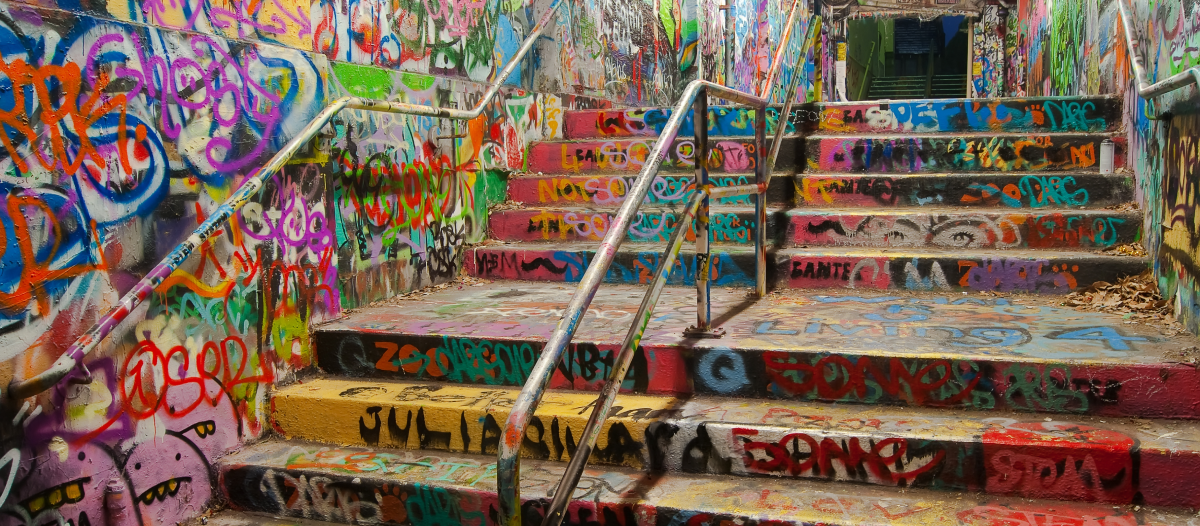Guarding Against Graffiti
Protocols that help prevent & remove graffiti on college campus buildings

Institutional buildings are powerful symbols within communities, and throughout history this has made them targets during periods of protest, unrest and conflict. During a recent historical period of campus protest, campus buildings have again been targets of graffiti, leaving colleges and universities with the costs and challenges of remediating the graffiti without causing additional damage to the buildings. Understanding this phenomenon as part of a cyclic pattern of civil unrest, the stewards of these buildings are encouraged to look beyond the current moment of campus protest and associated incidents of graffiti, toward a holistic, proactive approach to graffiti response that increases institutional resiliency.
Anti-vandalism management programs
Following the widespread protests and associated vandalism in 2020, Page & Turnbull, in collaboration with Gensler and the United States General Services Administration (GSA), Western Region (Region 9), embarked on an in-depth study to develop a more resilient approach to responding to graffiti, particularly on institutional buildings where graffiti is both a chronic and acute concern. Because there is no one-size-fits-all solution to addressing graffiti, coordinated planning, response and review processes are essential to increasing institutional resiliency and empowering building owners and managers to respond quickly and effectively to incidents of graffiti when they occur. Vandalism, including graffiti, resulting from mass protest should be considered more in the context of disaster response than traditional building maintenance.
An effective anti-vandalism management program begins by identifying the crucial stakeholders and personnel responsible for responding to incidents of graffiti and establishing clear communication protocols for rapid response. It next involves assessing campus buildings to catalog the existing materials at the buildings and pre-testing potential cleaning products and methods that can be used by on-site janitorial or maintenance staff in the immediate aftermath of an event with minimal risk of further damage. Installation of permanent anti-graffiti coatings and/or overly aggressive removal procedures often cause as much damage to building materials as the act of vandalism. Therefore, it is critical that the front-line personnel undertaking rapid response understand when that damage may start to occur and know when to stop to allow for a more specialized course of action. To that end, this advanced preparation process should be used to develop clear "quick start" guides for personnel, illustrating the optimal flow of removal processes for each identified building material.
Finally, an effective management program includes tools for identifying when a specialist is needed for additional graffiti removal and substrate repairs, along with assessment and documentation of the removal efforts to continue to build institutional knowledge of graffiti removal practices.
Assess campus buildings
Knowing the age, structural composition, materials and finishes of each campus building is critical information for a graffiti removal guide and the manual should reflect those conditions, as appropriate. Special considerations may be needed for historic buildings, whose structural materials may be more porous or fragile, and more easily damaged by graffiti removal efforts. Historic materials are also likely to be more difficult to repair or replace than materials used on newer buildings.
For instance, a school’s graffiti-removal guide should include limits to pressure applied to an affected area during the clean-up process to mitigate the risk of further damage to the building from the use of inappropriate pressure. Likewise, pre-testing and approving detergents and other cleaning agents can help prevent chemical damage to building materials and specifying the type of bristles for brushes used to scrub off paint – such as metal versus natural or synthetic fiber bristles – helps avoid accidental markings.
Vetting newly introduced graffiti removal products and technologies also can be useful in safe and effective remediation practices, including innovations like laser-cleaning by a trained conservator or specialist for disfigurement removal on, perhaps, marble statutes or limestone. Testing of graffiti removal products and techniques should be performed at inconspicuous locations prior to more general applications.
It is also valuable for the guide to address multiple applications of graffiti during a single incidence, and the protocols used to assess the overall damage in a way that is akin to triage to determine the most to least severe incidences and the order in which they are treated.
Understand graffiti removal and repair protocols
When dealing with the aftermath of graffiti, timeliness is an important factor—the sooner the graffiti is removed, the higher the success rate and the less permanent damage will be done. At the same time, realistic expectations of graffiti removal are also important with the safest and least harmful tactics sometimes requiring time-intensive slow, methodic processes.
Because the media (paints, marker, blood, etc.) used for the graffiti and the type and age of the building surface that the vandalism is applied to vary, removal products and techniques involved in the remediation process also vary.
Overly aggressive removal of graffiti can result in scratched, flaked or otherwise damaged surfaces that go beyond graffiti’s superimposed disfigurement. Stone surfaces, for instance, are porous, fragile and susceptible to harsh abrasives and cleaning techniques, with each type and finish of stone possessing different types of physical properties and vulnerabilities. For example, a polished finished stone will be easier to remediate than a rough textured stone. Other examples include limestone, which is liable to absorb chemicals from heavy cleaners, and glazes often applied to terracotta may be ruined or removed through aggressive remediation.
Another point is the condition of a building’s curtain wall and its integrity to withstand intense graffiti removal procedures. This can be especially true with recently historic mid-century modern buildings where there is the potential that heavy-handed pressurized water treatment may result in seepage into the building’s interior.
In some cases, a graffiti-resistant coating or film can be applied to building surfaces, but the finish can affect the intended look of the surface and the coatings need to be reapplied regularly to be effective. It may also be possible to replicate or nearly replicate finishes that are removed or damaged in the clean-up process.
Prepare a safeguard strategy
Often, iconic campus buildings are the most vulnerable to being vandalized by graffiti, with historic or prominent structures that symbolize a meaningful idea, period or ethos among the most targeted. Civic unrest can spur protestors into marking representative landmarks and other buildings with messages or images, as recently occurred at University of California, Los Angeles, whose iconic Royce Hall was targeted.
As institutions of higher learning in a democratic society, it is necessary for colleges and universities to balance deterrence strategies with values of accessibility and freedoms of assembly and speech. With advanced notice it may be possible to deploy effective temporary barriers to protect sensitive structures, but natural barriers such as shrubs, trees, thorned greenery, and other landscape solutions can also be carefully placed to impede would-be vandals without creating a fortress-like environment.
Be aware of high-risk features on buildings
It is important to know which areas on buildings are most at-risk for damage from vandalism and breakage, such as windows and doors. Strategies to harden these weak points for building security, such as impact-resistant glazing or wood-clad steel doors, should be sensitive to the character of historic and monumental buildings, particularly for more permanent installations, and may not be appropriate in all cases. The goal of these designs is to slow the progress of would-be vandals enough to allow security personnel time to respond, helping to safeguard buildings, reduce damage and ensure the safety of people.
The creative use of architecture can also help deter structural vandalism without compromising a campus’ open design as an inviting gathering place, such as visually appealing structural elements that prevent people from accessing a building’s windows and roof from the outside. Other considerations include moveable barriers that can be quickly set in place as needed, and wire fencing camouflaged by natural plantings like climbing vines.
Protecting campus buildings from graffiti vandalism requires a planned approach that safely meets the needs of the specific situation. It requires a patient, step-by-step process that considers the attributes of the building being restored and safety of all people involved.

John D. Lesak, AIA, LEED AP, FAPT, is a principal in charge of Page & Turnbull’s Southern California office in Los Angeles. With an interdisciplinary education in architecture, engineering, and materials science, Lesak specializes in the preservation, rehabilitation, repair and reuse of historic civic and institutional structures.

Sarah E. Brummett, AIA, is the director of Page & Turnbull's preservation architecture studio. Her architectural practice engages the dynamic relationships between historic architecture and landscapes, in addition to the challenges of security and accessibility in historic buildings operating in the 21st century.
Read more on Occupancy & Human Factors , Real Estate and Risk Management
Explore All FMJ Topics









